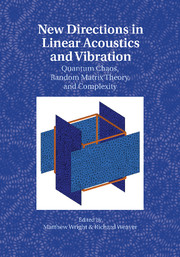Book contents
- Frontmatter
- Contents
- Foreword by Michael Berry
- Introduction
- 1 The Semiclassical Trace Formula
- 2 Wave Chaos for the Helmholtz Equation
- 3 The Unreasonable Effectiveness of Random Matrix Theory for the Vibrations and Acoustics of Complex Structures
- 4 Gaussian Random Wavefields and the Ergodic Mode Hypothesis
- 5 Short Periodic Orbit Theory of Eigenfunctions
- 6 Chaotic Wave Scattering
- 7 Transfer Operators Applied to Elastic Plate Vibrations
- 8 Mesoscopics in Acoustics
- 9 Diagrammatic Methods in Multiple Scattering
- 10 Time-Reversed Waves in Complex Media
- 11 Ocean Acoustics: A Novel Laboratory for Wave Chaos
- 12 Mesoscopic Seismic Waves
- 13 Random Matrices in Structural Acoustics
- 14 The Analysis of Random Built-Up Engineering Systems
- References
- Index
1 - The Semiclassical Trace Formula
Published online by Cambridge University Press: 05 October 2010
- Frontmatter
- Contents
- Foreword by Michael Berry
- Introduction
- 1 The Semiclassical Trace Formula
- 2 Wave Chaos for the Helmholtz Equation
- 3 The Unreasonable Effectiveness of Random Matrix Theory for the Vibrations and Acoustics of Complex Structures
- 4 Gaussian Random Wavefields and the Ergodic Mode Hypothesis
- 5 Short Periodic Orbit Theory of Eigenfunctions
- 6 Chaotic Wave Scattering
- 7 Transfer Operators Applied to Elastic Plate Vibrations
- 8 Mesoscopics in Acoustics
- 9 Diagrammatic Methods in Multiple Scattering
- 10 Time-Reversed Waves in Complex Media
- 11 Ocean Acoustics: A Novel Laboratory for Wave Chaos
- 12 Mesoscopic Seismic Waves
- 13 Random Matrices in Structural Acoustics
- 14 The Analysis of Random Built-Up Engineering Systems
- References
- Index
Summary
Introduction
For a two-dimensional enclosure, such as a membrane or the cross section of an infinitely long duct, those with the very simplest shapes (circles, rectangles, spheres, boxes, etc.) with simple uniform boundary conditions, the modes and natural frequencies can be determined analytically. For any other shape they may be determined numerically by a range of mature numerical techniques of which finite element and boundary element analyses are the best known and the most widely studied. Knowing how to calculate the modes and natural frequencies for any particular shape, however, is not the same as understanding how those modes and natural frequencies depend on the shape. Suppose, for example, that we wish to improve the design of a component by optimizing some quantity such as weight, while leaving its natural frequencies unchanged. In the course of such an optimization changes will be made to the shape, whereupon the process of calculating the modes and natural frequencies must begin all over again; at best, part of the mesh can be re-used. Such an analysis cannot tell us where effort can be most or least profitably concentrated.
It turns out that the shapes that can be analyzed are (for good reason) quite untypical compared with arbitrary shapes. The situation mirrors the one that used to prevail in the study of dynamical systems, where linear differential equations were most widely studied because of their solubility, and the fact that other systems showed radically different qualitative behavior was, for a time, ignored.
- Type
- Chapter
- Information
- New Directions in Linear Acoustics and VibrationQuantum Chaos, Random Matrix Theory and Complexity, pp. 5 - 23Publisher: Cambridge University PressPrint publication year: 2010



